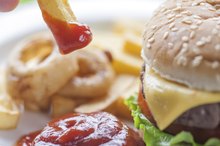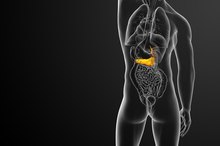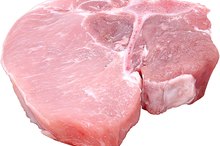Side Effects of Gallstones
The gallbladder is an organ that produces specific enzymes necessary for digestion. Gallstones are a common condition that affect approximately 15 percent of people older than age of 50, as noted on the Better Health Channel website 2. Gallstones are small solid masses that form within the gallbladder and are typically composed of cholesterol, calcium, or bile—an enzyme stored within the gallbladder. Though most people with this condition do not experience symptoms, it is possible to develop side effects from gallstones.
Abdominal Pain
Gallstones can lead to the development of abdominal pain in some people. Pain caused by gallstones often occurs in the middle or right side of the upper abdomen beneath the ribcage. Depending upon the size and location of the gallstone, abdominal pain can radiate into the upper back. Certain people notice that these symptoms worsen after eating a meal that is high in fat, such as a cheeseburger or pizza. Some people also experience episodes of abdominal gas, nausea or discomfort after eating. Chronic diarrhea can also develop in people with gallstones. Abdominal pain caused by gallstones is typically intermittent and can last for about an hour. Episodes of abdominal pain caused by gallstones can be recurrent but often do not reappear for several months or years following the first attack.
- Gallstones can lead to the development of abdominal pain in some people.
Jaundice
Gallbladder Infection Symptoms
Learn More
If a gallstone becomes stuck within the bile duct, bile can begin to accumulate in the body and cause jaundice to develop. Jaundice is a medical condition that results in the yellowing of the skin or eyes. As bile accumulates within the body, your urine can appear very dark or stools can appear pale. If you develop jaundice, speak with your doctor for further evaluation as this symptom may be indicative of another type of infection.
- If a gallstone becomes stuck within the bile duct, bile can begin to accumulate in the body and cause jaundice to develop.
Fever
A gallstone stuck within the bile duct can lead to an infection referred to as cholangitis, says the University of Maryland Medical Center 1. Symptoms of a bile duct infection include nausea, vomiting, fever, chills and severe abdominal pain. If you develop such symptoms, seek emergency medical treatment to prevent further complications. You could require an antibiotic or alternate medication to resolve this infection.
- A gallstone stuck within the bile duct can lead to an infection referred to as cholangitis, says the University of Maryland Medical Center 1.
- You could require an antibiotic or alternate medication to resolve this infection.
Related Articles
References
- University of Maryland Medical Center: Gallstones and gallbladder disease - Symptoms
- National Institute of Diabetes and Digestive and Kidney Diseases. Symptoms & Causes of Gallstones. Updated November 2017.
- Stinton LM, Shaffer EA. Epidemiology of gallbladder disease: cholelithiasis and cancer. Gut Liver. 2012;6(2):172-87. doi:10.5009/gnl.2012.6.2.172
- Johns Hopkins Medicine. Gallstones.
- National Institute of Diabetes and Digestive and Kidney Diseases. Dieting & Gallstones. Updated November 2017.
- Johansson K, Sundström J, Marcus C, Hemmingsson E, Neovius M. Risk of symptomatic gallstones and cholecystectomy after a very-low-calorie diet or low-calorie diet in a commercial weight loss program: 1-year matched cohort study. Int J Obes (Lond). 2014;38(2):279-84. doi:10.1038/ijo.2013.83
- Johns Hopkins Medicine. Gallstones.
- Mayo Clinic Staff. Gallstones. Mayo Clinic. Updated November 17, 2017.
- National Institute of Diabetes and Digestive and Kidney Diseases. Dieting and Gallstones. National Institutes of Health. U.S. Department of Health and Human Services. Updated November 2017.
- National Institute of Diabetes and Digestive and Kidney Diseases. Symptoms and Causes of Gallstones. National Institutes of Health. U.S. Department of Health and Human Services. Updated November 2017.
- Portincasa P, Di Ciaula A, Grattagliano I. Preventing a Mass Disease: The Case of Gallstones Disease: Role and Competence for Family Physicians. Korean Journal of Family Medicine. 2016;37(4):205-213. doi:10.4082/kjfm.2016.37.4.205.
Writer Bio
Rae Uddin has worked as a freelance writer and editor since 2004. She specializes in scientific journalism and medical and technical writing. Her work has appeared in various online publications. Uddin earned her Master of Science in integrated biomedical sciences with an emphasis in molecular and cellular biochemistry from the University of Kentucky College of Medicine.









